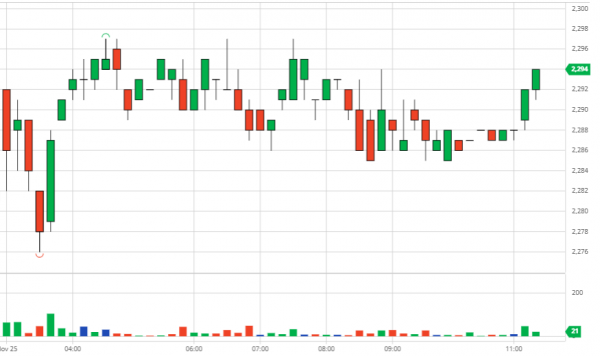Robusta coffee prices regained momentum thanks to the island price structure still maintained on the London floor…

London Robusta chart January 1, 2022 session on November 25, 2021
At the end of the session, the price of Robusta coffee on ICE Europe – London reversed to increase. Futures for delivery in January increased by 11 USD, to 2,292 USD/ton and term for delivery in March increased by 6 USD, to 2,228 USD/ton, slight increases. Trading volume Very low, rare. The island price structure widens the gap.
Meanwhile, ICE US exchange – New York American Thanksgiving holiday, no trading.
The price of green coffee beans in the Central Highlands provinces increased by 100-200 VND, up to range from 42,000 to 42,500 VND/kg.
Export price of Robusta coffee grade 2.5% black broken, stood at 1,978 USD/ton, FOB – HCM, with a deduction of about 220 – 250 USD/ton according to the March futures price in London.
The reais gained 0.53%, the rate was up at 1 USD = 5,5650 Reais, due to low liquidity and the USDX slump when US stocks closed for the holiday. The reais recovered slightly but also supported Brazilians to reduce selling and coffee prices on the BMF in São Paulo followed a slight increase with a small volume.
The London Robusta market regains momentum when trading alone thanks to a support island price structure. However, because the volume of transactions is so low, nothing can be concluded.
According to the forecast of the Foreign Agricultural Service (FAS) under the US Department of Agriculture (USDA), in the new coffee year 2021/2022, Vietnam will export an increase of 980,000 bags of coffee, or an increase of about 4.47%. compared to exports of the last coffee crop year.
According to Robusta coffee traders in Southeast Asia, this increase in Vietnam’s exports is not comparable to the number that has been blocked and unable to deliver because of the covid-19 epidemic in the past few months. via. Therefore, in the short term, the supply of Robusta will still be tight at least until the end of the first quarter of 2022, when the island price structure on the London floor will still be maintained.
The weather in the Central Highlands coffee area is cloudy and rainy, which is not favorable for harvesting and drying new crop coffee. However, this also slows down the ripening of coffee cherries, supporting a serious shortage of workers, while many localities have to implement social distancing measures to prevent disease.
ANhan Van (giacaphe.com)
